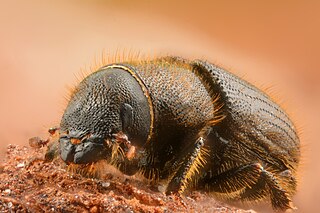
Thomas Say was an American entomologist, conchologist, and herpetologist. His studies of insects and shells, numerous contributions to scientific journals, and scientific expeditions to Florida, Georgia, the Rocky Mountains, Mexico, and elsewhere made him an internationally known naturalist. Say has been called the father of American descriptive entomology and American conchology. He served as librarian for the Academy of Natural Sciences of Philadelphia, curator at the American Philosophical Society, and professor of natural history at the University of Pennsylvania.
Qəzli is a village in the Ismailli Rayon of Azerbaijan. The village forms part of the municipality of Mican.
Mican is a village and municipality in the Ismailli Rayon of Azerbaijan. It has a population of 2,996. The municipality consists of the villages of Mican and Qəzli.

Morellia is a very large genus from the fly family Muscidae. Morellia are plumpish black flies, largely lacking eye hairs - sparse at most. they have a white dusting on the parafacialia and the scutum has 4 distinct longitudinal stripes.
Olisthopus is a genus of ground beetle native to the Palearctic, the Near East and North Africa. It contains the following species:

Mordellistena is a genus of beetles in the family Mordellidae, containing the following species:
Mordellistena dives is a species of beetle in the family Mordellidae which is in the genus Mordellistena. It was described in 1876 by Emery. and can be found in Hungary and southern part of Russia.
Mordellistena olympica is a species of beetle in the genus Mordellistena of the family Mordellidae, which is part of the superfamily Tenebrionoidea. It was discovered in 1965 and can be found in such countries as Bulgaria, Greece, Kosovo, Montenegro, Serbia, the Republic of Macedonia, and Voivodina.
Mordellistena majuscula is a species of beetle in the genus Mordellistena of the family Mordellidae, which is part of the superfamily Tenebrionoidea. It was discovered in 1977 and is endemic to Italy.
Mordellistena mediogemellata is a species of beetle in the family Mordellidae which is in the superfamily Tenebrionoidea. It was discovered in 1977 and can be found in Hungary and the European part of Turkey.
Mordellistena microgemellata is a species of beetle in the genus Mordellistena of the family Mordellidae, which is part of the superfamily Tenebrionoidea. It was discovered in 1965 and lives in such countries as Bulgaria, Greece and Cyprus.
Mordellistena mihoki is a species of beetle in the Mordellistena of the family Mordellidae, which is part of the superfamily Tenebrionoidea. It was discovered in 1977, and can be found in such countries as Croatia, Germany, Hungary, Romania, and Ukraine.
Mordellistena minima is a species of beetle in the family Mordellidae which is in the superfamily Tenebrionoidea. It was discovered in 1854 and can be found in Europe, Near East and North Africa. In Europe, it can be found on such islands as Balearic, Corsica, and Sicily, and in such mainland countries as Bulgaria, France, Greece, Hungary, Spain, all states of former Yugoslavia, and in European part of Turkey.
Mordellistena neglecta is a species of beetle in the genus Mordellistena of the family Mordellidae. It was described by Ermisch in 1977 and is endemic to Hungary.
Mordellistena paraintersecta is a species of beetle in the genus Mordellistena of the family Mordellidae. It was described by Ermisch in 1965 and can be found in countries such as Greece, Hungary, southern part of Russia and Near East.

Mordellistena variegata, the tumbling flower beetle, is a species of beetle in the genus Mordellistena in the family Mordellidae. It was described by Johan Christian Fabricius in 1798.

Xylocopa micans, also known as the southern carpenter bee, is a species of bee within Xylocopa, the genus of carpenter bees. The southern carpenter bee can be found mainly in the coastal and gulf regions of the southeastern United States, as well as Mexico and Guatemala. Like all Xylocopa bees, X. micans bees excavate nests in woody plant material. However, unlike its sympatric species Xylocopa virginica, X. micans has not been found to construct nest galleries in structural timbers of building, making it less of an economic nuisance to humans. Carpenter bees have a wide range of mating strategies between different species. The southern carpenter bee exhibits a polymorphic mating strategy, with its preferred method of mating changing as the season progresses from early spring to mid summer. Like most bees in its genus, the southern carpenter bee is considered a solitary bee because it does not live in colonies.

Grays Thurrock Chalk Pit is a 17.3-hectare (43-acre) Site of Special Scientific Interest in Grays in Essex. It is part of Chafford Gorges Nature Park, which is managed by the Essex Wildlife Trust.

Dendroctonus micans, the great spruce bark beetle, is a species of bark beetle native to the coniferous forests of Europe and Asia. The beetles burrow into the bark of spruce trees and lay eggs which develop into larvae that feed on the woody layers under the bark.






